Overview
The article centers on the critical outbound sales metrics that leaders must monitor to refine their sales strategies effectively. It emphasizes essential metrics, including:
- Conversion rates
- Customer acquisition costs
- Lead response times
By tracking these metrics, organizations can optimize their sales processes, enhance efficiency, and ultimately drive revenue growth through informed, data-driven decisions. This focus on metrics not only empowers leaders to make strategic choices but also fosters a culture of continuous improvement in sales performance.
Introduction
In a rapidly evolving sales landscape, understanding the metrics that drive outbound success is more crucial than ever. Leaders are presented with a unique opportunity to leverage essential outbound sales metrics to refine their strategies, enhance revenue generation, and foster sustainable growth. However, with an overwhelming array of data points available, how can sales teams effectively pinpoint which metrics truly matter? This question is vital to ensuring that their outbound efforts yield tangible results.
The complexity of the data can be daunting, yet it is essential to focus on the metrics that will truly impact success. By identifying and prioritizing key performance indicators, sales teams can streamline their strategies and drive meaningful outcomes.
As we delve deeper into the realm of outbound sales metrics, it becomes evident that a strategic approach is necessary. The right metrics not only inform decision-making but also empower teams to adapt and thrive in a competitive environment. Thus, understanding what to measure is not just beneficial; it is imperative for sustained growth and profitability.
Websets: AI-Powered Lead Generation for Accurate Outbound Sales Metrics
Websets harnesses advanced AI algorithms to deliver precise , empowering teams to navigate extensive datasets and pinpoint potential leads that align with specific criteria. This level of accuracy is crucial for effectively tracking outbound sales metrics, guaranteeing that the analyzed data remains both relevant and actionable. By enriching search outcomes with comprehensive information, Websets equips leaders to make informed decisions based on exact data, thereby refining their outbound strategies. The integration of AI streamlines the measurement process, allowing teams to focus on high-value tasks, ultimately driving improved results in lead generation and engagement.
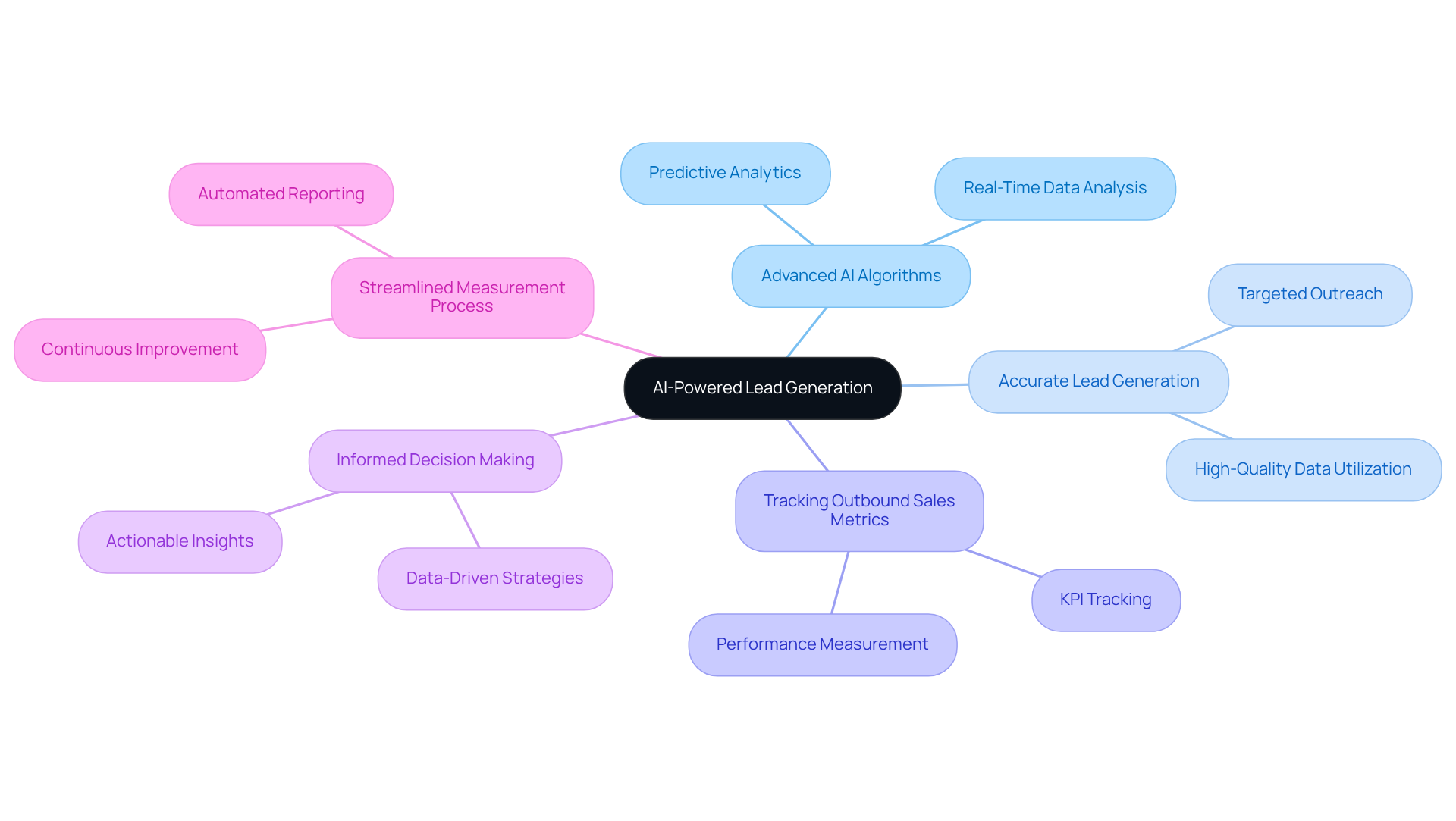
New Business Revenue: Measure the Impact of Outbound Sales Initiatives
New business income serves as a vital metric for evaluating the effectiveness of outbound sales metrics in marketing efforts. By meticulously tracking income generated from new customers acquired through these strategies, business leaders can assess their impact with precision. This metric underscores not only the immediate financial benefits of commercial activities but also offers insights into the long-term viability of the selling strategy. Regular analysis of this data allows teams to refine their outreach methods, concentrating on high-impact strategies that drive revenue growth.
Organizations [leveraging Websets' AI-powered tools](https://insights.exa.ai/10-ap-is-for-talent-signals-every-startup-should-consider) for prospect generation and data enrichment can significantly [enhance their sales workflows](https://insights.exa.ai/10-cold-email-follow-up-tips-to-boost-your-response-rates). For instance, entities that have adopted Websets' solutions report an average productivity increase of 10-15% and a remarkable 30% reduction in costs. This underscores the importance of . Sales leaders must focus on monitoring essential outbound sales metrics, such as conversion rates, customer acquisition costs, and response times, to identify bottlenecks and refine their strategies.
As highlighted by industry specialists, 'Sales automation will remain a crucial element of commercial technology, enabling companies to streamline processes, enhance efficiency, and drive revenue growth.' As the landscape evolves, maintaining a clear focus on new business revenue will be essential for navigating the competitive market of 2025 and beyond.
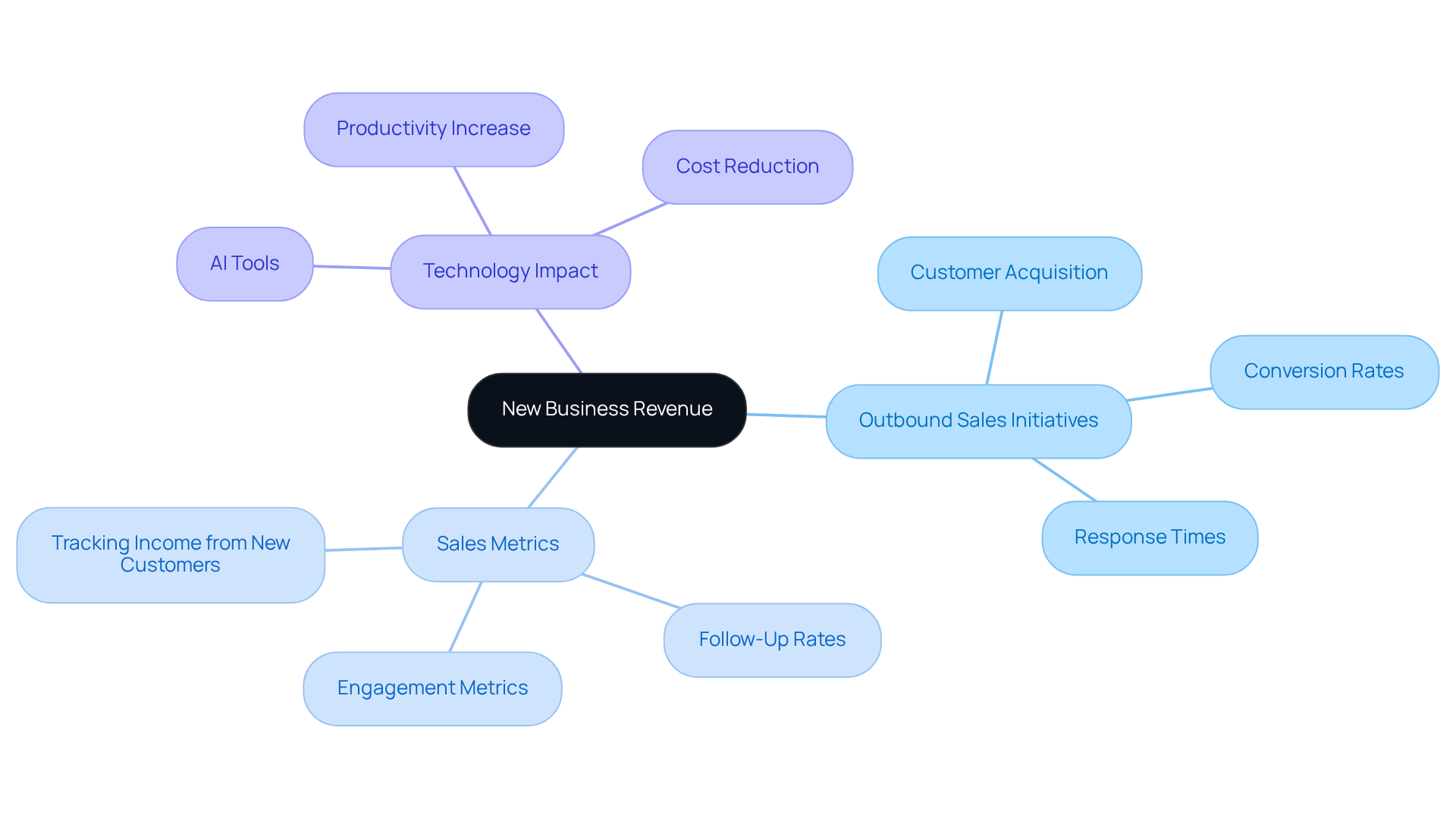
Conversion Rates: Track the Efficiency of Your Outbound Sales Process
Outbound sales metrics, such as conversion figures, serve as a crucial metric for assessing the success of your selling initiatives, reflecting the percentage of leads that convert into paying clients. In 2025, the average conversion rate across sectors hovers around 2.35%, with top organizations achieving rates exceeding 5.31%. By meticulously analyzing outbound sales metrics, sales teams can pinpoint bottlenecks in their selling processes and implement targeted strategies for improvement. Notably, firms utilizing AI-driven sales tools report an average increase of 20% in conversion rates, with 71% of organizations adopting these technologies witnessing significant performance enhancements, underscoring the impact of technology on efficiency.
High conversion rates indicate effective sales tactics, while lower outbound sales metrics may necessitate a thorough reassessment of outreach methods or prospect qualification processes. Industry experts assert that a well-structured inbound strategy can be ten times more effective than traditional outbound methods regarding lead conversions. Furthermore, customized outreach has been shown to yield response rates that are 32% higher than generic approaches, and personalized calls to action (CTAs) outperform standard ones by 202%, emphasizing the importance of tailoring communication to individual prospects.
To , sales teams should focus on continuous improvement by regularly evaluating their outbound sales metrics. This includes implementing organized follow-up strategies, considering that 80% of transactions require at least five follow-ups, while 44% of representatives abandon prospects after just one attempt. By fostering a culture of persistence and leveraging data-driven insights, organizations can significantly enhance their conversion rates and overall revenue performance.
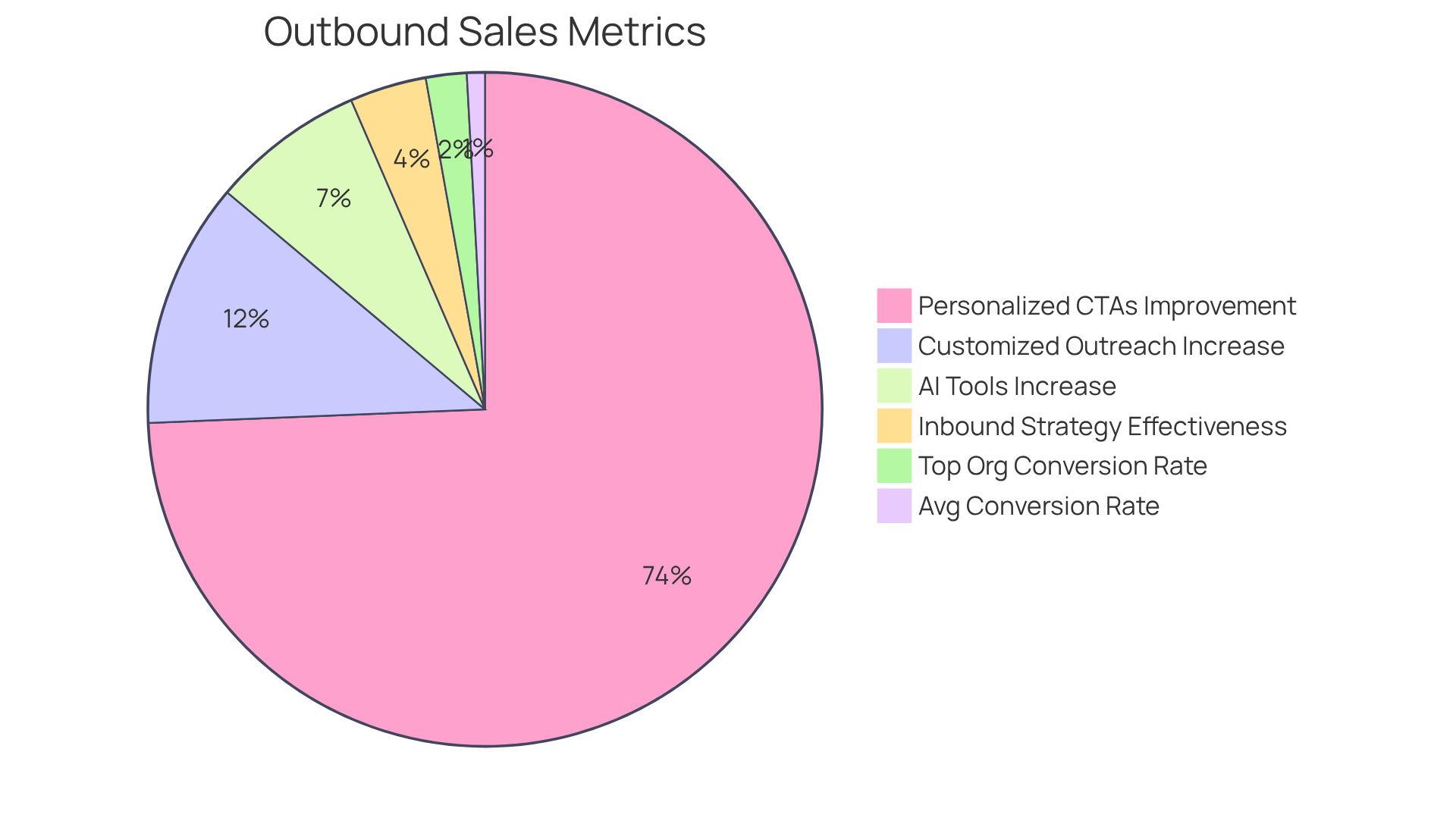
Projected Pipeline Sales Value: Forecast Future Revenue from Outbound Sales
The projected pipeline revenue value is a crucial metric for accurately predicting future income from outbound sales metrics. By evaluating the overall worth of potential agreements within the revenue pipeline, leaders gain essential insights into anticipated income, enabling informed decisions regarding resource allocation and strategic adjustments. This metric empowers teams to prioritize high-value opportunities, directing their efforts toward leads with the greatest likelihood of conversion, thereby driving significant revenue growth.
In 2025, effective revenue prediction from outbound transactions will hinge on understanding buyer behaviors, particularly in The Dark Funnel™, where 70% of B2B purchasers navigate their journey without revealing their intent. Sales leaders must harness advanced analytics and AI tools to enhance forecasting accuracy, ensuring the capture of all potential opportunities. As the 6sense Team notes, "By having a clear picture of your expected revenue, you can proactively address any financial challenges, optimize resource allocation, make data-driven decisions, seize growth opportunities, and set realistic, achievable goals for your organization."
Mark Niemiec, Chief Revenue Officer at Salesloft, emphasizes, "The top selling teams will utilize AI to make execution instinctive while managers concentrate on human coaching to enhance performance in areas technology cannot instruct." This underscores the importance of integrating technology with strategic human oversight to improve business outcomes.
Ultimately, understanding and calculating is vital for crafting a robust business strategy that incorporates outbound sales metrics, allowing organizations to adapt swiftly to market changes and maximize their income potential. It is also essential to recognize that the accuracy of the pipeline revenue model can be influenced by workforce estimates, which may not consistently account for external market fluctuations.
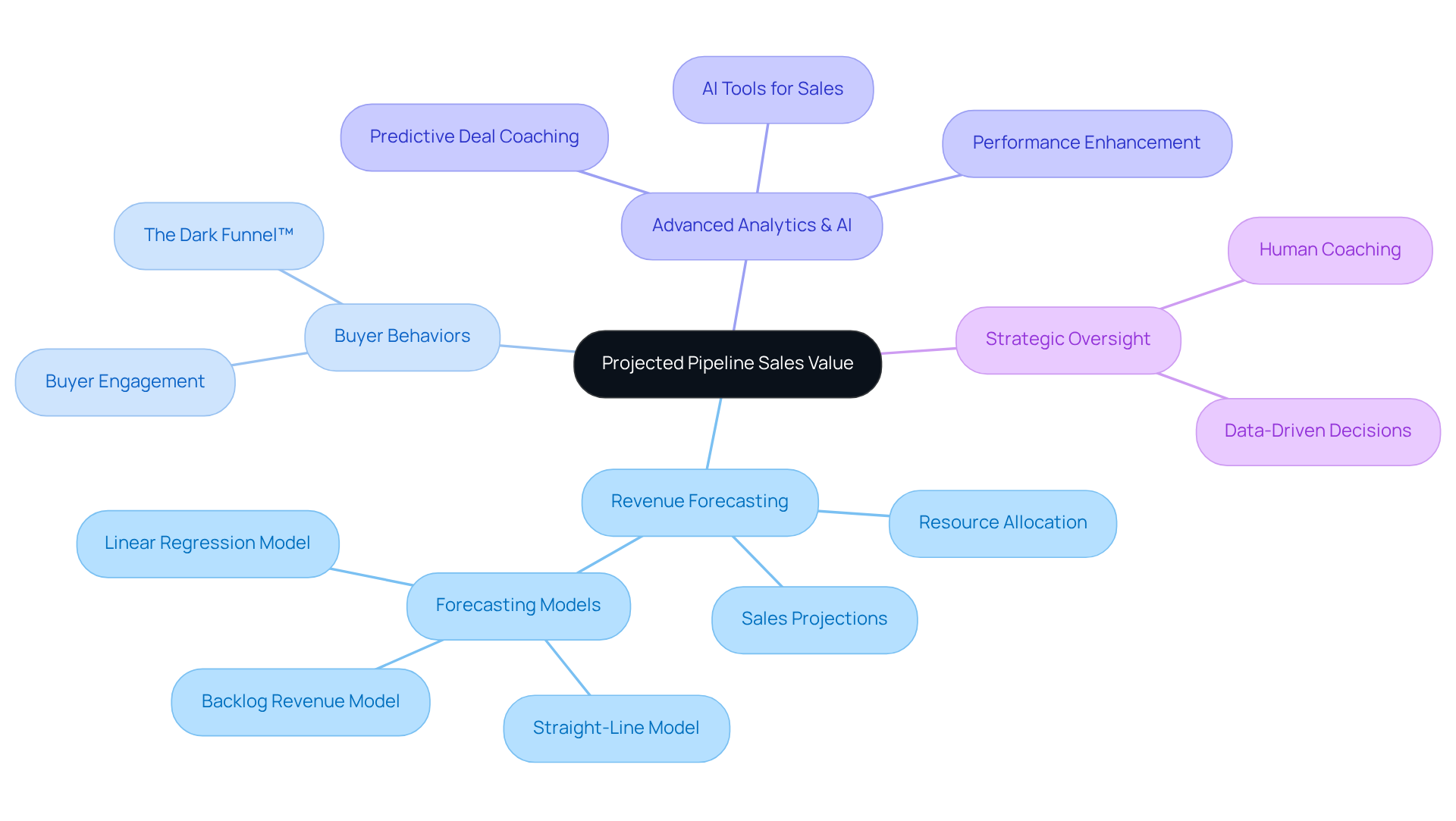
Outbound Sales Growth: Evaluate the Success of Your Sales Strategies
Outbound sales metrics are a critical measurement for evaluating the effectiveness of strategies aimed at revenue growth. By tracking outbound sales metrics over time, teams can assess the impact of their outreach initiatives and identify patterns that reveal both successes and opportunities for enhancement. This metric reflects the overall vitality of the revenue pipeline and guides strategic adjustments aimed at boosting performance and fostering sustainable growth. In 2025, organizations emphasizing organized revenue training and incorporating a robust RevOps framework are anticipated to achieve a 353% return on investment. This underscores the significance of ongoing assessment and adjustment of revenue strategies.
As Matthew Iovanni observes, establishing an Ideal Customer Profile (ICP) is essential for identifying the right prospects, significantly improving outbound revenue effectiveness. Moreover, consistent evaluation of outbound sales metrics, along with key metrics such as response rates and conversion rates, enables teams to refine their strategies, ensuring that outreach efforts align with evolving market demands. Utilizing can further enhance these efforts by providing accurate lead generation and data enrichment solutions tailored for sales teams.
For instance, case studies illustrate how various companies have effectively employed Websets to bolster their outbound marketing strategies. Furthermore, the Websets API offers rapid and precise web search functionalities, enabling teams to access essential data efficiently. However, it is crucial to acknowledge the challenges faced in this domain, as cold emails have seen a notable decline in open rates due to heightened spam filters. This reality necessitates a balanced perspective on outbound marketing effectiveness.
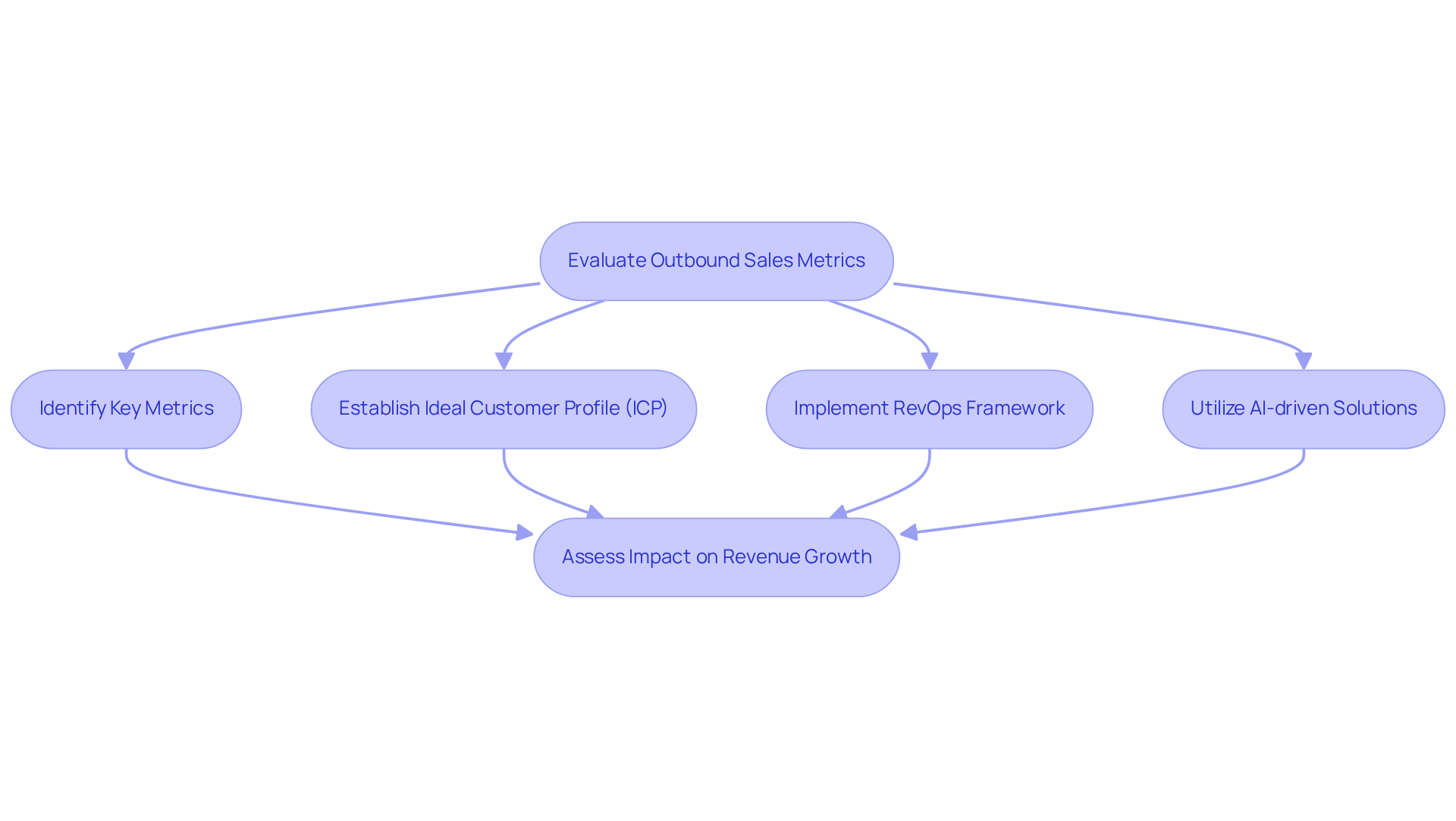
Lead Response Time: Optimize Engagement with Prospective Customers
Lead response time is a pivotal metric within outbound sales metrics that gauges how swiftly sales teams connect with potential customers following initial contact. Research shows that replying to inquiries within the first five minutes can boost conversion rates by as much as 391%. However, the likelihood of qualifying a prospect decreases by 80% after the first five minutes, underscoring the urgency of quick responses. This swift involvement not only increases the chances of qualifying prospects but also signals to potential clients that the business is attentive and dedicated to their needs.
To enhance response time for prospects, sales groups should consider utilizing via Websets' AI-powered platform, directing inquiries automatically to sales for immediate response times. Furthermore, leveraging Exa's advanced search features, including link similarity and keyword search, can improve company research and prospect generation. This enables teams to focus on high-value prospects for faster engagement.
Creating a clearly defined response strategy fosters a consistent approach and accelerates the improvement of outbound sales metrics. As Kyle Parrish observes, "The quicker you can reach a prospect, the more probable they are to convert." Businesses that prioritize swift responses are more likely to build trust and foster long-term relationships with their customers.
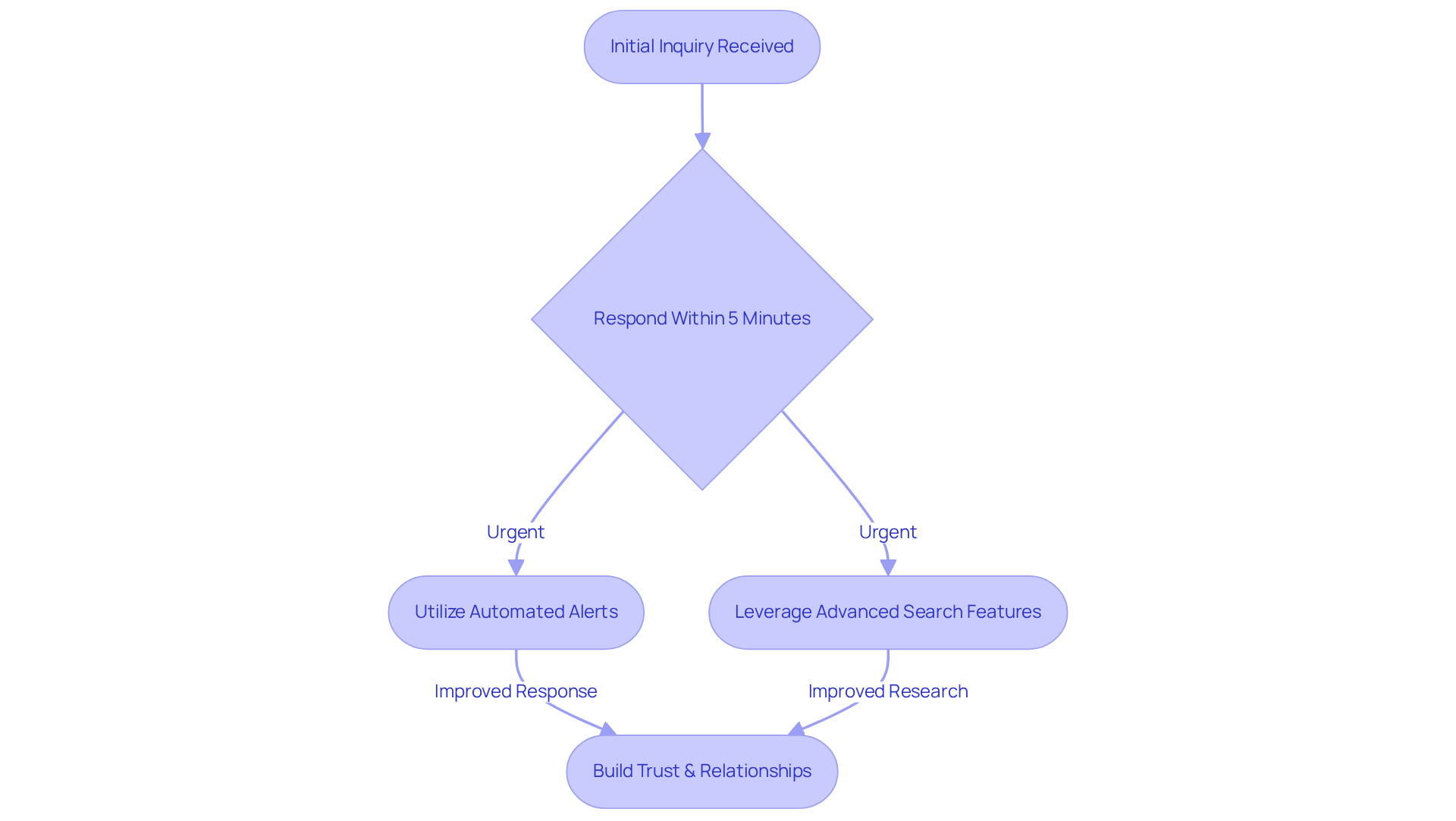
Sales Cycle Length: Analyze the Duration of Your Outbound Sales Process
Sales cycle length defines the total duration from the initial contact with a prospect to the finalization of a deal. This crucial metric, known as , serves as a benchmark for evaluating the effectiveness of your outbound selling process. A shorter business transaction cycle often indicates successful marketing strategies and robust prospect qualification. In contrast, an extended cycle may reveal bottlenecks or inefficiencies that demand attention. For instance, organizations that refine their negotiation and contracting processes can save as much as nine weeks in decision time, thereby enhancing overall revenue speed.
Moreover, with Websets' adaptable, high-capacity rate limits, sales teams can efficiently manage peak enterprise demands, ensuring that no opportunity is overlooked during critical periods. By consistently monitoring the duration of the sales cycle, teams can identify areas for improvement and implement strategies that expedite deal closures. Furthermore, with premium support and custom Service Level Agreements from Websets, teams are equipped with the necessary resources to navigate complexities and enhance their lead generation efforts.
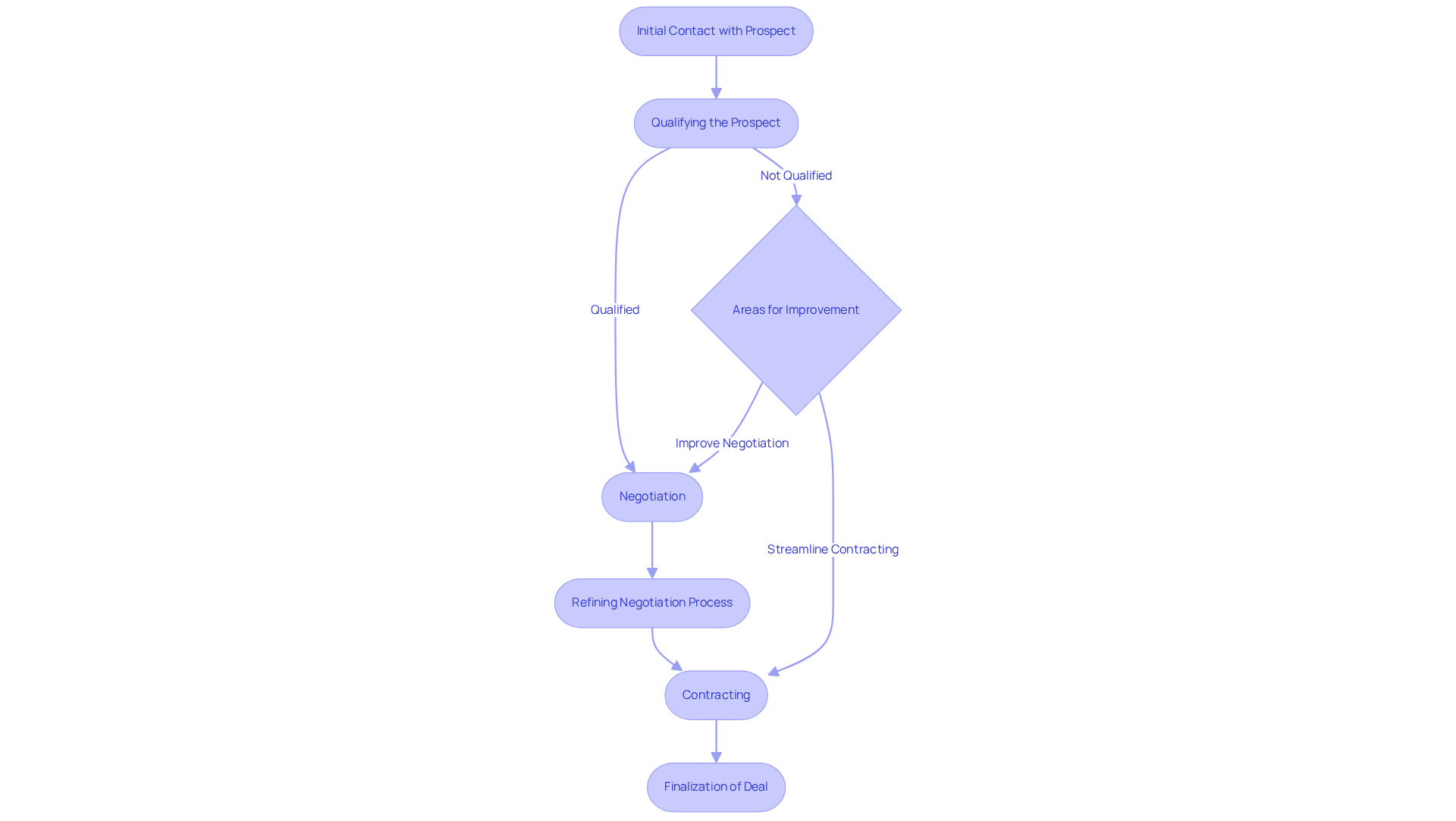
Customer Acquisition Cost (CAC): Assess the Financial Efficiency of Outbound Sales
Customer Acquisition Cost (CAC) serves as a crucial metric that quantifies the total expenses associated with acquiring a new customer, encompassing marketing, promotional efforts, and onboarding costs. In 2025, the average CAC for B2B SaaS hovers around $702, while sectors such as commercial insurance surpass $900. This disparity underscores the diverse financial landscapes across industries. By meticulously tracking CAC, revenue leaders can evaluate the financial efficiency of their outbound strategies. A lower CAC indicates a more cost-effective approach, while a higher CAC may signal the need for strategic adjustments in marketing or revenue tactics to bolster profitability.
Understanding the is vital for optimizing budget allocation. As one expert aptly puts it, "If you know how much it costs to acquire customers from different channels, you can optimize where you allocate your budget." Regular assessment of outbound sales metrics empowers organizations to refine their spending, ultimately maximizing return on investment and fostering sustainable growth.
To minimize CAC in B2B transactions, leveraging AI tools like those offered by Websets can lead to reductions of up to 50%. Organizations employing Websets' AI-driven solutions have reported significant improvements in prospect generation and data enhancement, enabling sales professionals to identify and engage high-quality prospects more effectively. Furthermore, implementing robust customer success initiatives that promote retention and referrals is essential. Referral programs, which boast one of the lowest CACs at $400, represent a potent strategy for organizations seeking to enhance revenue efficiency and secure long-term profitability.
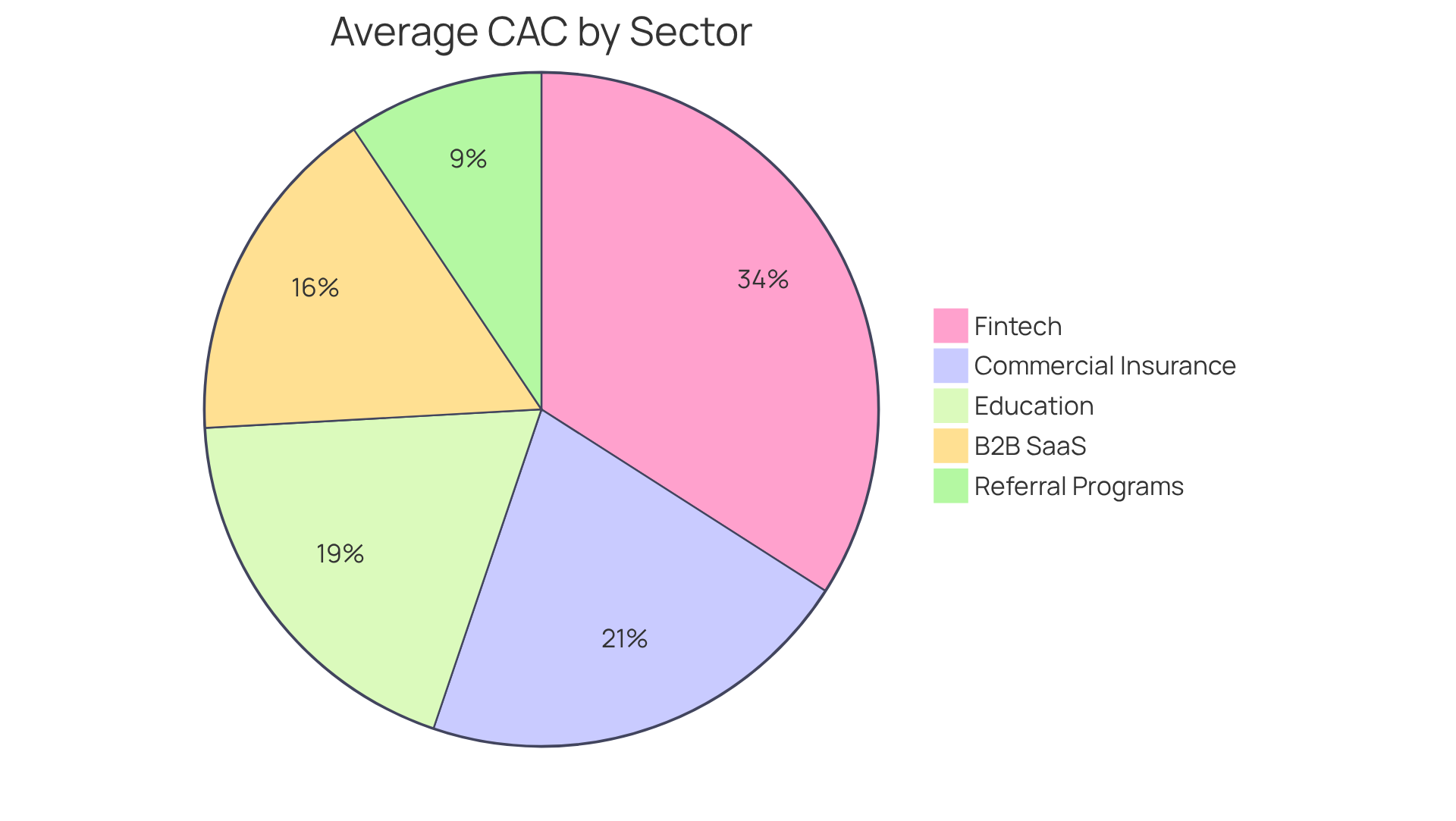
Follow-Up Rate: Measure Engagement and Nurturing of Leads
The follow-up frequency serves as a vital component of outbound sales metrics, measuring how often sales teams connect with prospects following the initial outreach. This metric is indispensable for evaluating the persistence and effectiveness of outbound sales metrics in lead nurturing efforts. Notably, high follow-up rates indicate a proactive strategy in engaging potential customers, which can significantly enhance conversion rates. In fact, 80% of transactions necessitate a minimum of five follow-ups, and 50% occur after the fifth contact. Alarmingly, 44% of representatives abandon their efforts after just one attempt, underscoring the critical need for a structured follow-up process.
To elevate engagement, ensures consistent communication with prospects, safeguarding against missed opportunities. Effective prospect nurturing techniques—such as personalized follow-ups and prompt responses—can yield a 20% increase in business opportunities. Nurtured leads indeed result in a 20% rise in business opportunities compared to their non-nurtured counterparts. Sales leaders assert that incorporating video into follow-up strategies can further bolster engagement and conversion rates. As one specialist aptly noted, "Persistence is essential in follow-up as it distinguishes successful representatives from those who are not."
Moreover, 55% of responses to cold email campaigns stem from follow-up emails, highlighting their effectiveness in engaging prospects. By concentrating on outbound sales metrics, sales teams can significantly enhance their lead nurturing initiatives and ultimately achieve greater success in their transactions.
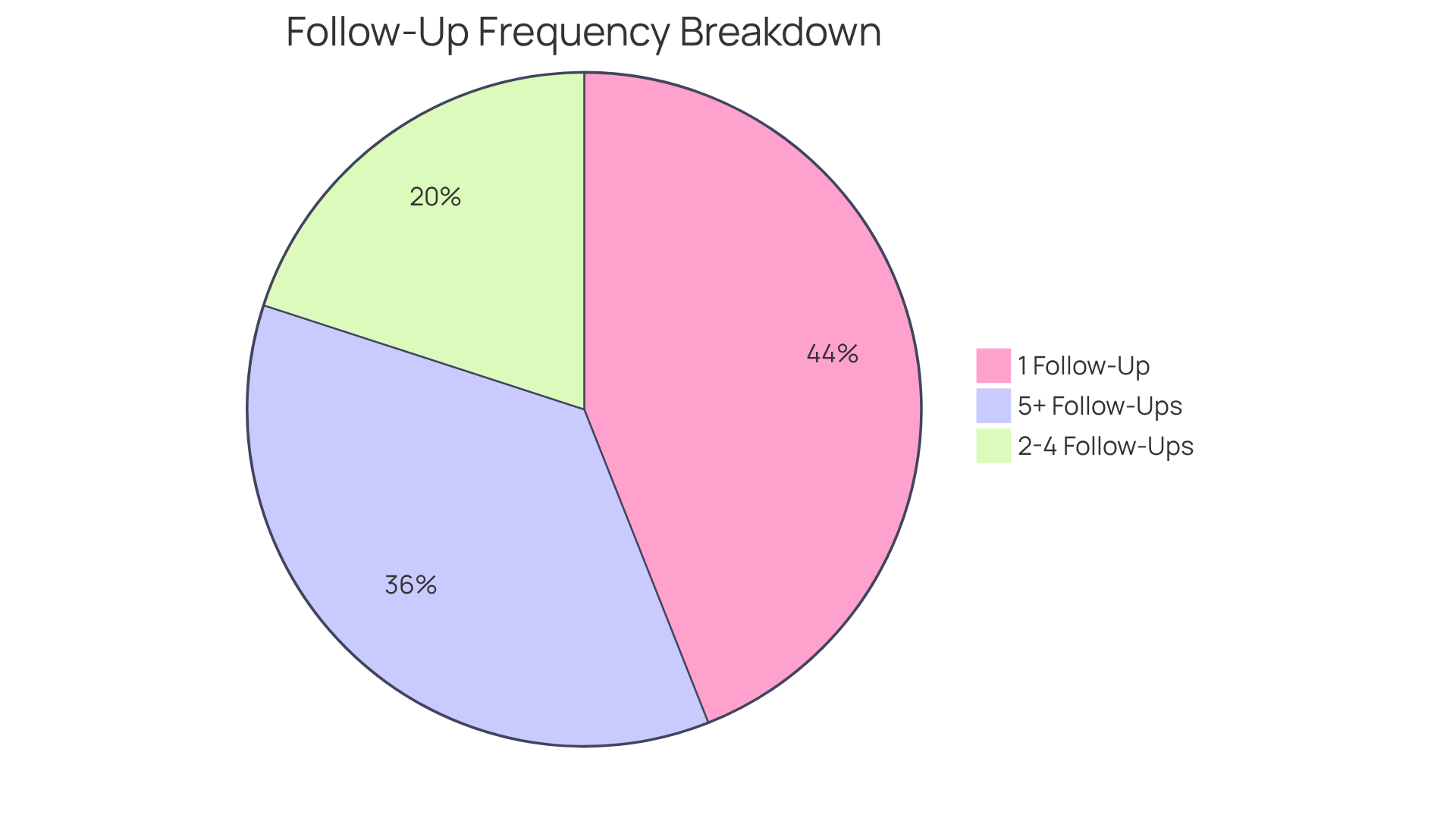
Churn Rate: Monitor Customer Retention and Long-Term Sales Success
Churn level is a critical metric that quantifies the percentage of customers who terminate their relationship with a business over a defined period. Understanding outbound sales metrics is essential for evaluating and the overall effectiveness of outbound marketing strategies. A high turnover frequency often signals underlying issues related to customer satisfaction or perceived product value, necessitating enhanced engagement strategies. By meticulously analyzing churn data, sales teams can develop targeted retention initiatives that not only strengthen customer loyalty but also promote sustainable revenue growth.
As industry experts have noted, proactive strategies to address churn can significantly elevate retention rates. For example, a mere 5% increase in retention can result in profit increases ranging from 25% to 95%. Furthermore, Shaoli Paul, a FinTech Content Expert, emphasizes, "Understanding churn allows businesses to allocate resources more efficiently, focusing marketing efforts on high-risk segments and prioritizing loyalty programs for high-value customers." Therefore, comprehending and managing churn is essential for evaluating outbound sales metrics and ensuring long-term business viability.
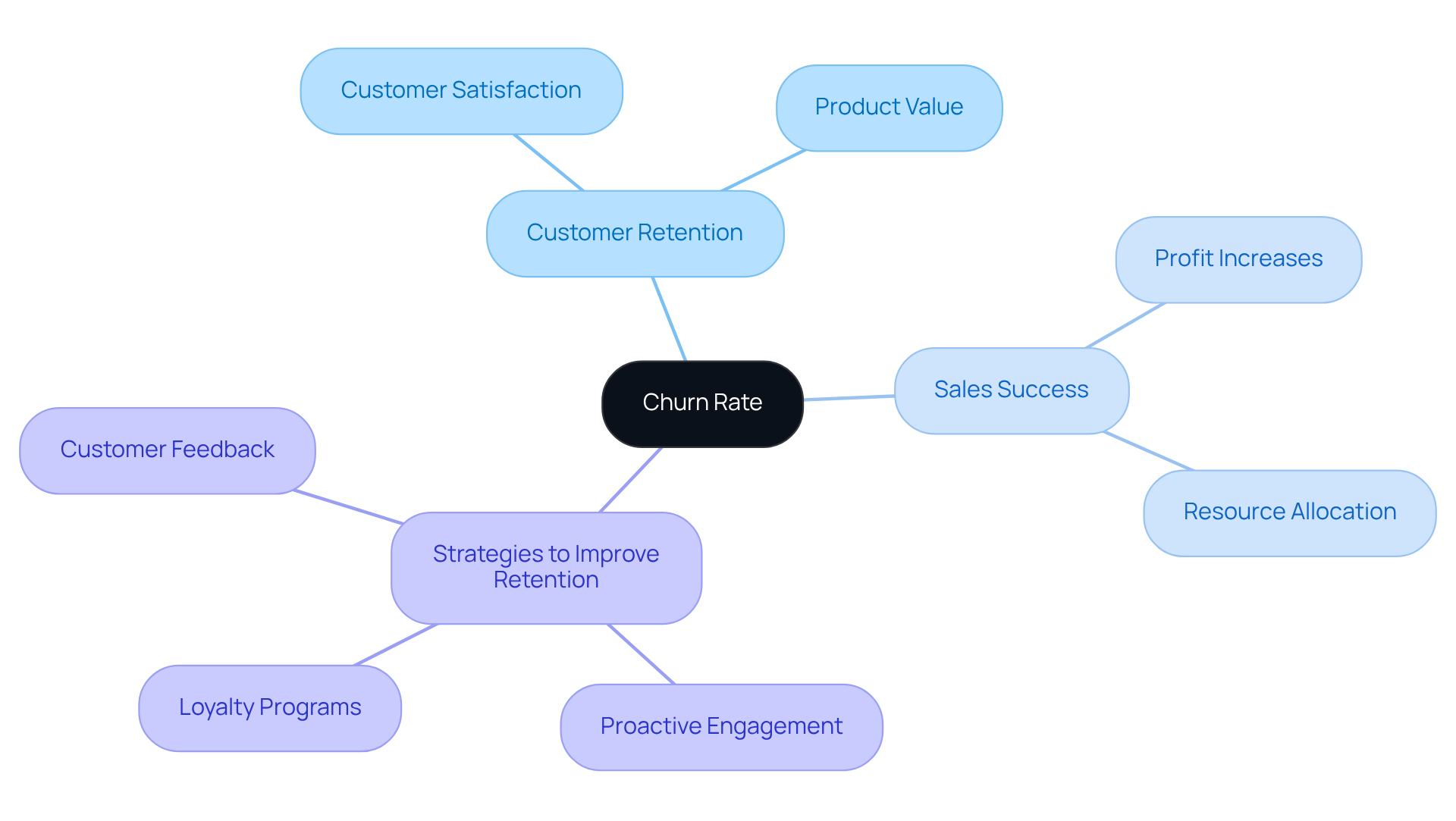
Conclusion
Understanding and effectively tracking essential outbound sales metrics is crucial for any leader aiming to enhance their sales strategies and drive revenue growth. By focusing on metrics such as conversion rates, customer acquisition costs, and lead response times, organizations gain valuable insights into their sales processes, enabling informed decisions that lead to improved performance.
Key points throughout the article emphasize the importance of leveraging advanced tools like AI-powered lead generation to refine outreach efforts and optimize sales workflows. Metrics such as new business revenue and projected pipeline sales value provide a clear picture of the effectiveness of outbound initiatives. Regular assessments of follow-up rates and churn rates ensure that teams remain engaged with prospects and retain existing customers. These insights empower organizations to adapt their strategies in a rapidly changing market environment.
In a landscape where competition is fierce, the emphasis on monitoring and analyzing outbound sales metrics cannot be overstated. Leaders are encouraged to adopt a proactive approach, utilizing technology and data-driven strategies to enhance their sales processes. By prioritizing these metrics, businesses can achieve immediate financial gains while fostering long-term relationships with customers. This ultimately ensures sustained success in their sales endeavors.
Frequently Asked Questions
What is Websets and how does it assist in lead generation?
Websets is a platform that utilizes advanced AI algorithms to deliver accurate lead generation functionalities, helping teams navigate large datasets to identify potential leads that meet specific criteria. This accuracy is essential for tracking outbound sales metrics effectively.
How does Websets improve outbound sales metrics?
By enriching search outcomes with comprehensive information, Websets enables leaders to make informed decisions based on precise data, refining their outbound strategies and allowing teams to focus on high-value tasks, which ultimately drives better results in lead generation and engagement.
What role does new business revenue play in evaluating outbound sales initiatives?
New business revenue is a critical metric for assessing the effectiveness of outbound sales strategies. It helps business leaders measure the income generated from new customers, providing insights into both immediate financial benefits and the long-term viability of selling strategies.
What productivity gains can organizations expect from using Websets?
Organizations that implement Websets' AI-powered tools for prospect generation and data enrichment report an average productivity increase of 10-15% and a 30% reduction in costs, highlighting the importance of advanced technology in optimizing outbound efforts.
Which outbound sales metrics should sales leaders monitor?
Sales leaders should focus on monitoring key outbound sales metrics such as conversion rates, customer acquisition costs, and response times to identify bottlenecks and refine their strategies for better performance.
What is the average conversion rate for outbound sales in 2025?
The average conversion rate for outbound sales in 2025 is approximately 2.35%, with top organizations achieving rates over 5.31%.
How can sales teams improve their conversion rates?
Sales teams can enhance conversion rates by analyzing outbound sales metrics to identify bottlenecks, implementing organized follow-up strategies, and focusing on personalized outreach, which has been shown to significantly increase response rates.
What impact does AI have on conversion rates?
Firms that utilize AI-driven sales tools report an average increase of 20% in conversion rates, with 71% of organizations adopting these technologies experiencing significant performance improvements.
What is the importance of persistence in sales outreach?
A culture of persistence is crucial, as 80% of transactions require at least five follow-ups, yet 44% of representatives abandon prospects after just one attempt. This highlights the need for continuous engagement to enhance conversion rates and overall revenue performance.




